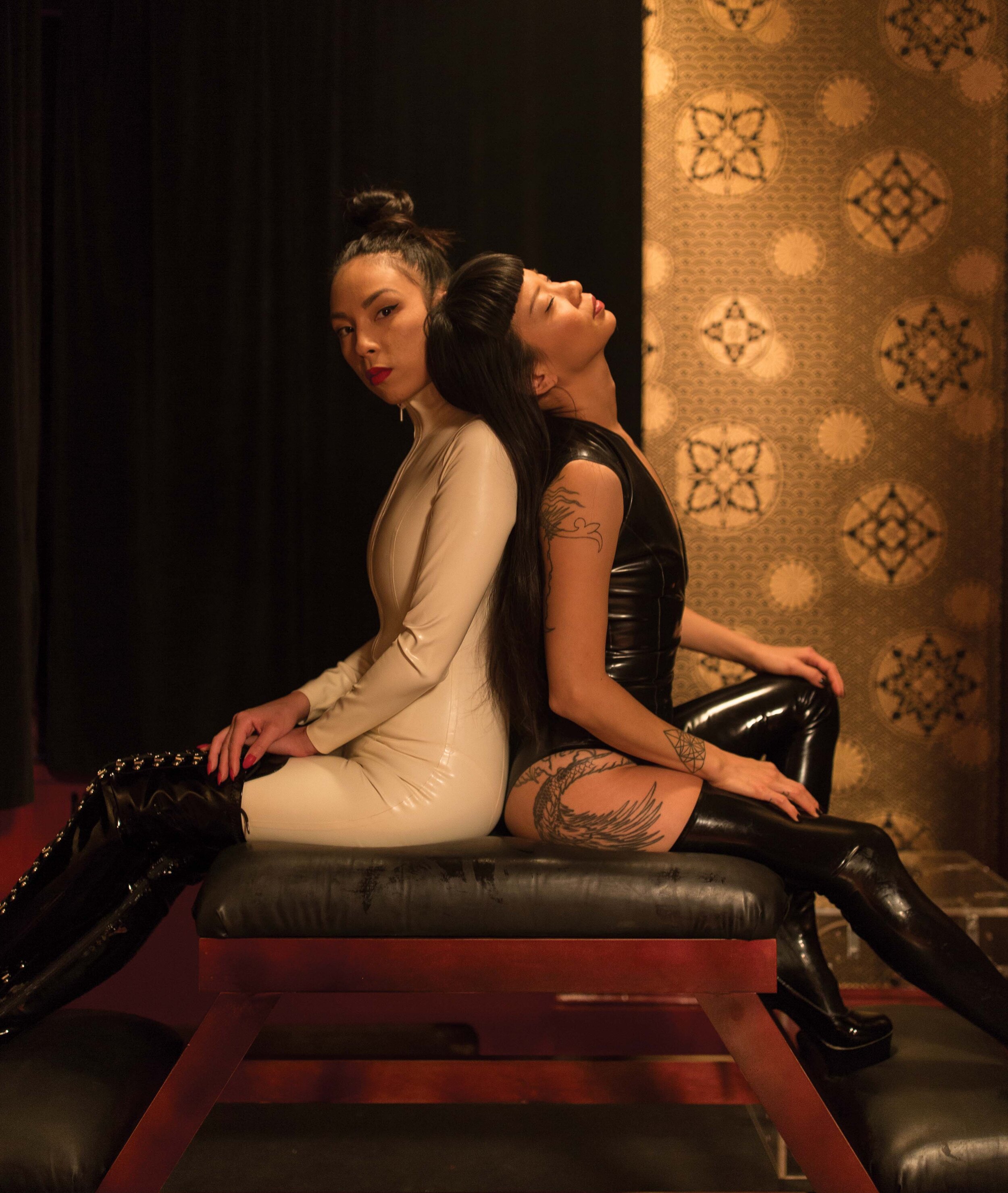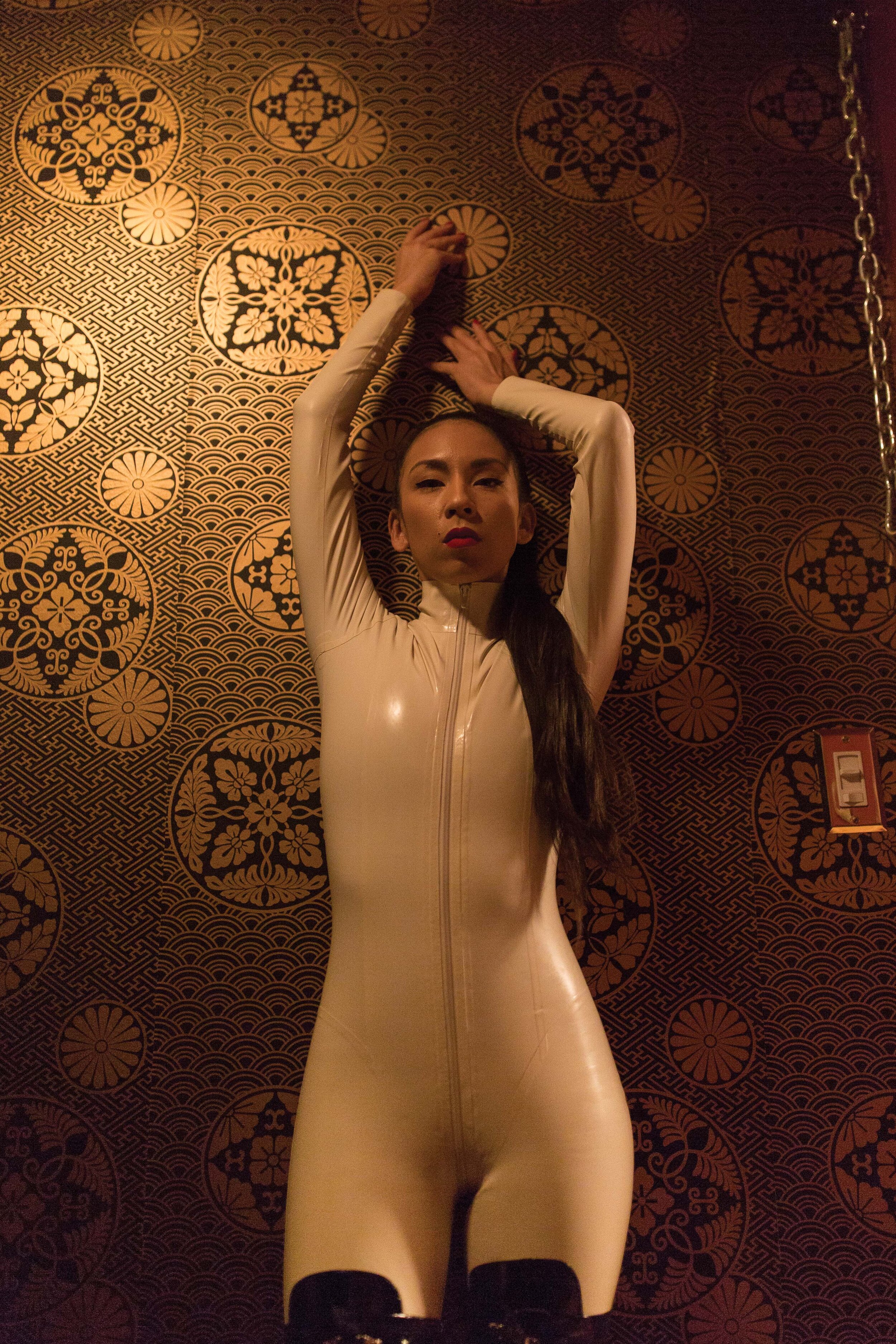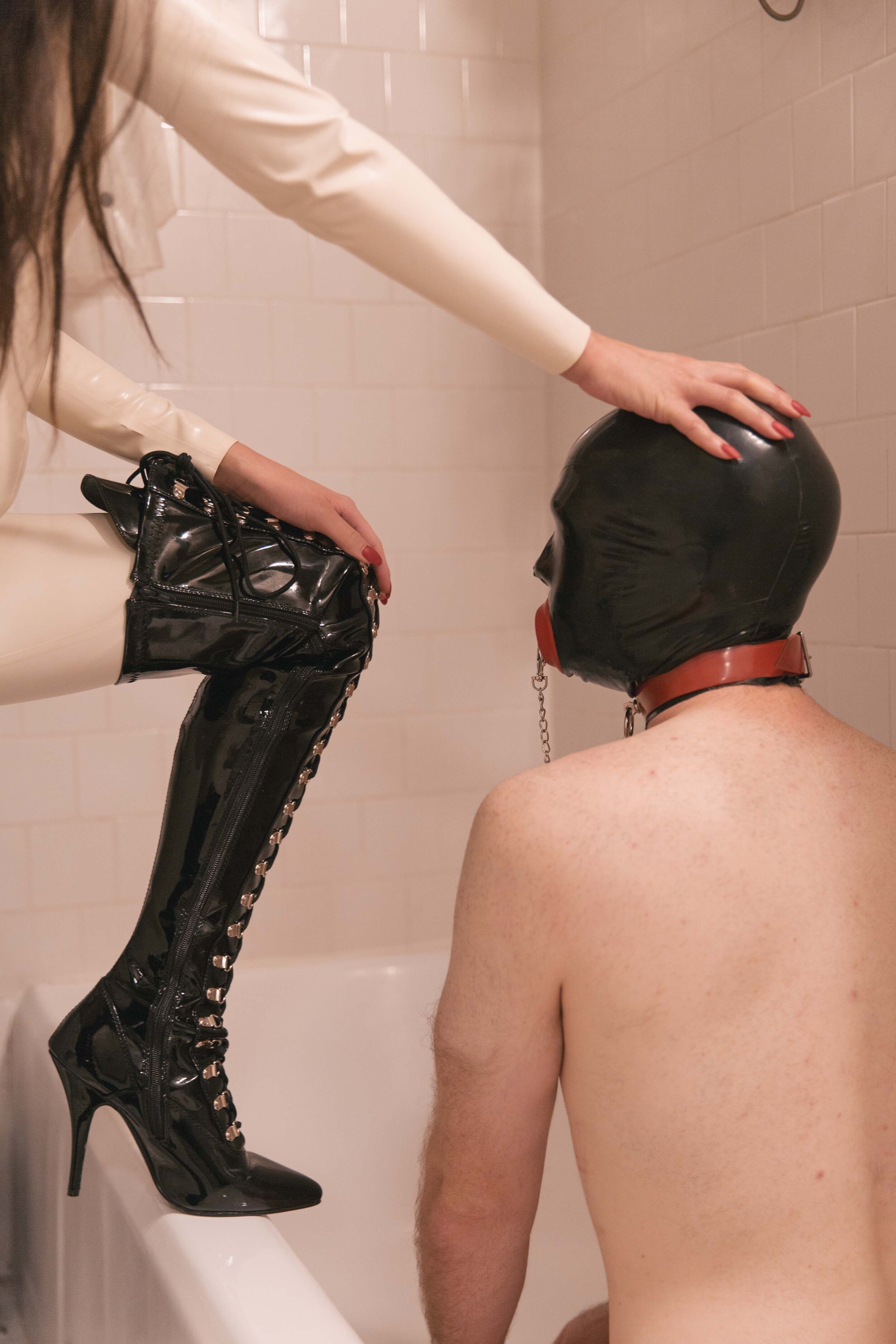Asian Dominatrixes
Asian Dominatrixes (From the Banana Archives: Issue 004)
Words: Tiffany Diane Tso
Photos: June Kim
“While I do not enjoy the aspect of being objectified, I am willing to work with it to educate the other by humanizing myself.”
In the 1999 film Payback, Lucy Liu plays a dominatrix named Pearl. Clad in patent leather lingerie and fishnets, she stomps on her boyfriend’s balls and recites the lines, “Me love you, baby, me love you long time.” Accurate media portrayals of sex workers of color are hard to come by in general, but from her criminality to her willingness to let her boyfriend beat her up, Liu’s character is a poor depiction of an Asian dominatrix.
Domination—a historically taboo career that combines sex work with BDSM—is already sensationalized in pop culture as a world of cracking whips, villainous dungeons, and anguished screams. But combining that with Orientalist, hypersexualized stereotypes—either the fragile “lotus blossom” or aggressive “dragon lady”—can send some in a tailspin of fetishization and prurient curiosity.
Which is why Domina Dia Dynasty and Mistress Lucy Sweetkill, two New York City professional dominatrixes (pro-dommes), warned against generalizing their experiences for the entire community.
Lucy, 32, is Vietnamese American, and Dia, 40, is Chinese American. They came into their unconventional careers in similar ways, but have opposing personalities. Lucy’s clients often call her “daddy,” because of her authoritative energy, while Dia’s ultra-feminine energy gets her the nickname “goddess” and sometimes, to her displeasure, “mommy.”
Dia and Lucy run their business out of La Maison du Rouge, a red-walled, mirror-filled private play space in Manhattan, where they also host weekly Periscope interviews with members of the kink community, sex workers, and experts. “I do not offer body worship, massage or sexual services of any kind, so please be respectful and do not ask,” Dia’s page reads, noting that you’re required to share references from other pro-dommes. She does offer BDSM services including medical role play, obedience training, humiliation, and degradation.
Lucy and Dia both began working as professional dominatrixes over eight years ago, when they separately answered Craigslist or Backpage ads seeking Asian women who wanted dominatrix training. The ads led them to employment at an all-Asian commercial “dungeon”—where practitioners go for BDSM services—in downtown New York City, where they became friends.
They both recognize that their ethnicity is a selling point. “People keyword search ‘Asian dominatrix,’” Lucy says. “My assumption is if you’re reaching out to me, you’re most likely reaching out to me because my race played some role.”
Different though their characters may be, the demographics of their clients are the same: predominately white men. Dia and Lucy say that roughly 95% of their clientele are cisgender men, 85–90% of which are white; sometimes heterosexual couples will visit and the woman will return alone.
They understand that by posting their artful boudoir shoots and fashionable candids online, as well as using keywords like “Asian dominatrix,” they are attracting a specific type of client. Google Trends shows far higher search frequencies for “Asian dominatrix” compared to “professional,” “white,” or “Latina” (though not as much “black dominatrix”). Yet they also see their marketing tactic as exploiting the fetishization of Asian women for a profit.
Even at her former job in fashion, Lucy’s employees would refer to her as a “dragon lady,” in both an endearing and negative way. She likes the association. “Yes, that’s definitely me. I’m a boss ass bitch,” Lucy says proudly. The association certainly helps in her positionality as a dominatrix and sex worker: She says her clients fear her.
“People tend to try to cross the line with sex workers,” Lucy says. “Most people won’t push with me, because they come into it not only knowing my reputation, but just maybe this energy that I give off.” The first thing she asks new clients is if they are nervous, and Lucy says they usually answer, “I’m scared of you.” Lucy laughs. “That’s a good emotion to have towards me.”
“I’ve never gotten ‘dragon lady,’” Dia admits, saying she’s more “subtle and gentle.” She refers to her role with her clients as “the goddess” and “the exalted female”—ultra-feminine and often using patience and tolerance as tools versus force. This doesn’t mean that she intentionally distances herself from the stereotype though.
“The ‘dragon lady’ stereotype would be great one day, if I can be that person,” Dia says. “I feel like I’m finally getting there, but I still don’t think that I’m quite as audacious or bold to have someone else perceive me as a ‘dragon lady.’”
Dia says that she enjoys turning the fetishist’s expectation on its head and defying stereotypes. “The sex worker stigma has a counteractive effect to the ‘model minority’ stereotype, but at the same time, brings up the idea of how media has singularly projected Asian sex workers as trafficked, submissive, and destitute,” she says. “It’s a rare treat and a coveted experience to be with a highly-sought after Asian sex worker, I imagine.”
Dia and Lucy have an anecdote about a client they call “Sadley” for the sake of anonymity. He would visit them at their old dungeon to role-play James Bond scenes, with himself as Bond and them as devious vixens. In order to check some of his white male privilege, they had him attend a weekend workshop they co-hosted to train him to be a better submissive.
“While I do not enjoy the aspect of being objectified, I am willing to work with it to educate the other by humanizing myself,” Dia says. “In my realm, it qualifies as an aspect of domination.”
“My assumption is...you’re most likely reaching out to me because my race played some role.” —Lucy
A BDSM educator and pro-domme for 18 years, Yin remembers the ads she used to place in newspapers and magazines. She would hold phone hours for people to call in, and she’d vet them. “It took a lot of time,” she says, now 43. “It was a lot more of an investment in terms of administrative work.”
Yin says the professional dominatrix community was “pretty closed off and not very inviting” when she tried getting her start as a pro-domme in New York City in the early ‘90s. “I went to a few of the dungeons to apply,” Yin recalls. “I was told by one of the major dungeons that they already had a Japanese mistress”—meaning they already had their token Asian.
“Asian fetishism, I feel, really became so marketable and became such a commodity,” says Yin Q.
Yin ended up navigating the city’s BDSM scene alone, first expressing sadomasochism onstage at a burlesque bar in Tribeca before moving to a more inclusive dungeon called The Shadows in the Bay Area. “As with any female who is really interested in exploring sexuality in an adventurous way, I think that if they don’t have the rules or the support and the education made possible to them before going into it, it can be dangerous,” she says. Eventually, she opened up her own playspace in Manhattan’s Financial District, which she nicknamed “the Dojo”: a well-lit private loft with white walls and tatami mats that hid soundproofing material.
Like Dia and Lucy, Yin also saw a majority cisgender white male clientele. She views the “dragon lady” stereotype as one with “layered complexities.” “I don’t want to say that I can necessarily dissociate completely from the ‘dragon lady’ trope, because to me she is powerful, and she is witchy, and she is magical, and she can manipulate men’s desires into money,” Yin explains. “Hell yeah, what’s wrong with that?”
She says she also understands the “lotus blossom” stereotype. “I think that as women, we have both in us,” Yin says, making the case that like any other virginwhore dichotomy, both sides can have elements of truth. Meanwhile, she can harness them to coax out more complex emotions. “For example, when I decide to don my inner dragon lady for an S&M session, instead of being the stereotype of cruelty, I use my dominance to assist the person out of depression or shame,” she says. “We can turn these experiences into something new and unique if we employ our archetypes and steer them differently.”
One coincidence tying the three women together is an element of their family life: all three women’s mothers are divorced from their fathers, even though divorce was taboo in the cultures they were brought up in. Asian Americans report the lowest divorce rates in the country, with less than one-fifth choosing legal separation. “I don’t want to make it seem like a pathological thing,” Yin warns. “I know a lot of dommes who have very happy, conventional families.”
The family trauma that Yin experienced in her childhood led her to seek out BDSM as a lifestyle. “I came into sexual awakening with the need to struggle, the need to feel like I’m pushing up against power,” she says. “That I’m playing different roles.” She went through phases of self-harm, cutting herself in early teenage years. “I’m very much a sadomasochist.” she says.
Dia’s mother also experienced abuse, which led her to leave Dia’s father early on. Because of this, her mother was seen as an “untraditional and unconventional” Asian woman. Dia says, “She defied a lot of conventions,” which made Dia feel more comfortable to do the same. “My mother felt really helpless, but she was also raised by a very strong mother herself,” who fled a war while pregnant. “There’s this kind of genetic passing of strength and independence in my family.”
Lucy attributes her strong will and dominating qualities to her independent and dominant mother. “She was like a ‘tiger mom’ and ‘dragon lady’ smashed together,” Lucy jokes. “She’s kind of this big force to be reckoned with, in this 4’11” body.”
While Lucy didn’t mention any abuse from her childhood, her parents also divorced. “I grew up with three really strong women in my life,” she says, referring to her mother and maternal grandmother, who were Vietnam War refugees, and her older sister.
If their mothers’ convention-breaking paved the way for Dia, Lucy, and Yin to pursue their own unconventional lifestyles, do they know what their daughters do for a living? If so, would they understand it?
Lucy’s mother thinks Lucy owns her own fashion consulting company, though her sister knows her real career. She assumes the secret will come out eventually.
Dia came out to her mother, reassuring her by leading the conversation with all of the practical elements, like that she was “making a lot of money, very safe, supporting herself, happy…”
Back when Yin was running her business out of the Dojo, she brought her mother in. Yin’s mom supports her endeavors, including “Mercy Mistress,” a web series she’s producing about her experiences as a Chinese American pro-domme in New York City. Her mother even contributed to the “Mercy Mistress” crowdfunding campaign. “She’s proud of me,” Yin says.
Yin explained to her mother that she helps others who have undergone similar struggles and trauma as her. “We all go through existential trauma,” Yin says. “It doesn’t necessarily need to be an acute sexual trauma. I think the women that come to see me, they might not have ever been [sexually violated], but they do understand what it is to constantly have to perform for somebody else and to always feel like they’re in a sexual space for someone else.”
This is one major takeaway about BDSM and pro-domme work: For some, it takes pain to heal. “The biggest misconception in what we do,” Lucy says, “is how actually caring [the work] is. People think it’s so mean and negative and hard and dark and cruel, and people are just getting beat.” On the contrary, she says, “it’s quite loving in many ways.”
Besides healing trauma and holding space for others to be their full kinky selves, Lucy and Dia say that they have also helped clients lose weight, get in shape, and learn new practices in spirituality and mindfulness in the forms of yoga and meditation.
One of Lucy’s clients, a 27-year-old white cisgender male submissive who works in the art world and goes by Pain Puppy, tweets photos to her of his healthy meals and exercise daily. “Seeing a pro-domme was a way for me to safely find out if I was really kinky or not,” says Pain Puppy, who acts as Mistress Lucy’s “slave.” In BDSM culture, a slave is a person who takes on the submissive role in a total power exchange (TPE) relationship. “I’ve always been kinky, but in my teens and in college, I would try to suppress those feelings and desires that were burning in me,” he says. “Seeing a pro-domme not only let me explore this side in a non-judgmental environment, but also with someone who knew what they were doing.”
Coming out as kinky has empowered Pain Puppy. “The responses from my friends were actually really amazing. Most were really happy that I found something I liked and were happy I was trying to be open about it.”
However therapeutic kink can be for clients, the three women clarified that BDSM cannot be a replacement for psychotherapy. And while some therapists tend to pathologize kinkiness, “there’s a big change too in therapy, where they are integrating the fact that BDSM and kink are part of people’s sexuality, and it’s not [all] coming from this place of trauma,” Lucy says.
Dia, Lucy, and Yin all work hard to destigmatize BDSM and kink, which requires them to be very visible in their advocacy: sitting on panels, throwing community events, and sharing their stories across various platforms. It’s a level of agency farremoved from the cringe-worthy “me so horny” sex worker.
These Asian American pro-dommes have taken control of their own narratives.
Thanks for reading and being a part of the Banana community! While we continue social distancing to combat the COVID-19 pandemic together, the Banana team wants to be a resource for you to stay inspired, hopeful, and creative. We'll be curating stories from our past issues every week to rediscover our ambitions and to remind ourselves to, even during these tough times, stay positive and celebrate the moments that bring us happiness and pride.
You can also:
Follow the contributors and those featured in this piece:
Dia Dynasty (@dia__dynasty)
Lucy Sweetkill (@mistresssweetkill)
Yin Q (@yinq13)
Tiffany Diane Tso (@tiffanydian)
June Kim (@junebugkim)











